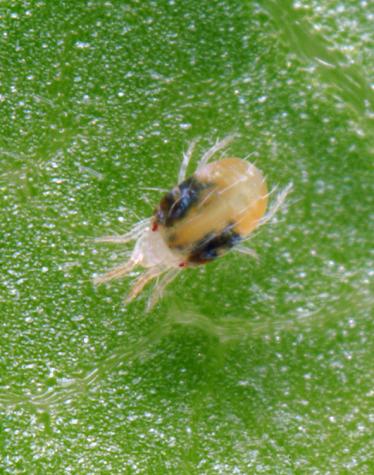Numbers grow quickly in dry weather.
COLUMBIA, Mo. – Scout now for spider mites, says University of Missouri Extension field crops entomologist Kevin Rice. Dry weather throughout the state creates ideal conditions for spider mite outbreaks.
MU Extension agronomists reported mites in fields across the state during their weekly teleconference on Aug. 26. Mite populations can double about every five to seven days under drought conditions.
“Do not wait too long to scout and treat,” Rice says. Untreated fields can see “explosive population growth.”
Mites are small organisms more closely related to chiggers and spiders than insects. The two-spotted spider mite, Tetranychus urticae, can cause yield loss in soybean and corn. It gets its name from the two dark spots on the sides of the mite's translucent greenish-yellow, white, orange or red body. Spider mites feed on the underside of soybean leaves and are hard to see due to their small size – about 1/60 of an inch.
Spider mites typically show up in soybean fields along field borders or waterways, But as populations increase, damage spreads across the field. Injury initially appears as yellow stipples, speckling or spots on soybean foliage. In heavy infestations, leaves turn yellow, then brown/bronze and finally drop from the plant.
Use at least a 10-times magnification lens or shake infested leaves over a white paper and watch for small yellow mites crawling about the paper.
In soybean, chemical control is warranted when spider mites are present and foliage yellowing reaches 20% before pod set or 10% after pod set.
Most pesticides do not kill spider mite eggs. Rice says additional applications are sometimes necessary five days after the initial treatment. Spider mites appear on numerous species of weeds along field borders. Weed control can reduce overwintering success and infestations in crops the following year.
Rains cause spider mite populations to collapse quickly. However, continue to scout mite-infested fields after rainfall since damaging levels of spider mites may redevelop if drought conditions return.
Contact your local extension center for management options. More information about spider mites is available in the MU Integrated Pest Management newsletter.
Photo available for this release:
Two-spotted spider mite
Photo by J. Holopainen, CC BY-SA 4.0.
